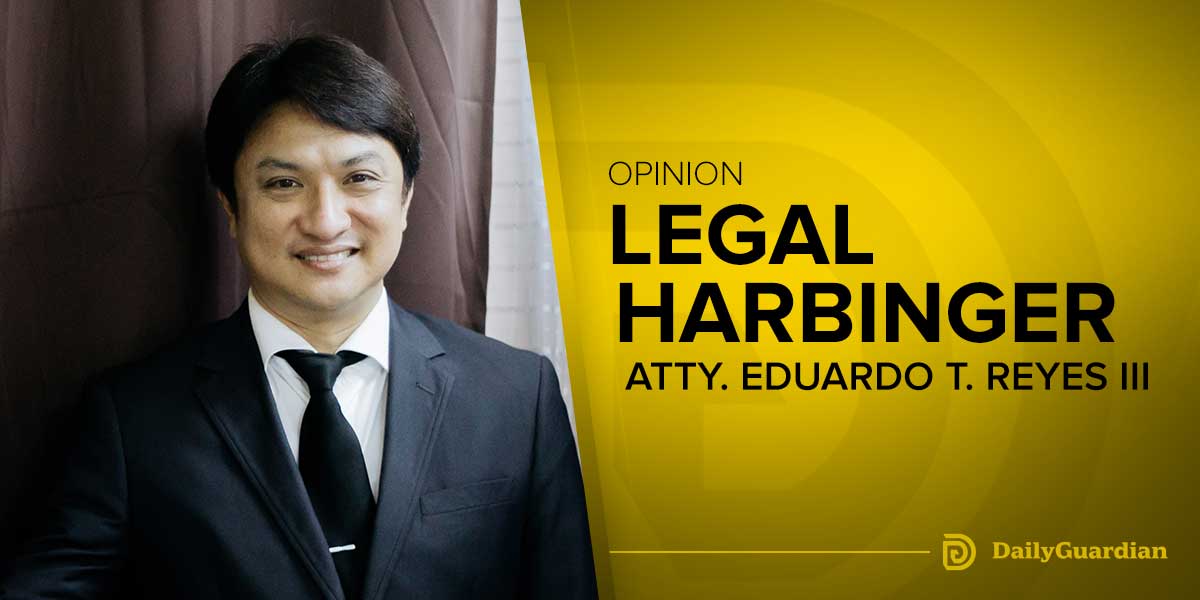
By Atty. Eduardo T. Reyes III
In life, we have our burdens to deal with. The same is true in criminal litigation. The prosecution’s burden is heavy: it must prove the guilt of the accused beyond reasonable doubt.
Although not as foolproof as “proof beyond all doubt”, “proof beyond a reasonable doubt” only rules out the possibility of error that an innocent person might lose his life, liberty or property over a crime he or she is charged with.
Jurisprudence in the past had interchanged “burden of proof” with “burden of evidence”. But under the 2019 Revised Rules on Evidence (A.M. No. 19-08-15-SC), these two “burdens” had been set apart from one another.
Section 1, Rule 131 provides that:
“BURDEN OF PROOF, BURDEN OF EVIDENCE AND PRESUMPTIONS
Section 1. Burden of proof and burden of evidence. – Burden of proof is the duty of a party to present evidence on the facts in issue necessary to establish his or her claim or defense by the amount of evidence required by law. Burden of proof never shifts.
Burden of evidence is the duty of a party to present evidence sufficient to establish or rebut a fact in issue to establish a prima facie case. Burden of evidence may shift from one party to the other in the course of the proceedings, depending on the exigencies of the case”.
In Alicia O. Fernandez, Anthony Joey S. Tan, Reynaldo V. Cesa and Edgardo V. Martinez v. People of the Philippines, G.R. No. 249606, handed down on July 6, 2022, burden of evidence was given a more detailed explanation, thus:
“The burden of evidence is defined as that logical necessity which rests on a party at any particular time during a trial to create a prima facie case in his own favor, or to overthrow one when created against him. It is determined by the progress of the trial, and shifts to one party when the other party has produced sufficient evidence to be entitled as a matter of law to a ruling in his favor. It may also be determined by the provisions of the substantive law or procedural rules, which may relieve the party from presenting evidence on the fact alleged, i.e., presumptions, judicial notice, and admissions”.
Inevitably, while the burden of proof always lies with the prosecution in criminal proceedings, the burden of evidence shifts when an affirmative defense is raised by the accused, ie., self-defense in a homicide or murder case, or consensual sex in a rape charge.
When the nature of the defense is one which on one hand admits the act complained of but on the other, provides a legal justification or excuse for it, the order of the trial may be reversed such that instead of the prosecution laying down its evidence first, the defense must go first.
A reverse order of trial is sanctioned by three (3) rules, thus:
1)Section 3 (e), Rule 119 of the Rules of Court which provides as follows:
(e) When the accused admits the act or omission charged in the complaint or information but interposes a lawful defense, the order of trial may be modified.
2) The second paragraph of Section 7 of Republic Act No. 8493 (Speedy Trial Act) and its implementing Circular No. 38-98, specifically the second paragraph of Section 3 of the Circular, thus:
Republic Act No. 8493, Section 7:
x x x
If the accused pleads not guilty to the crime charged, he/she shall state whether he/she interposes a negative or affirmative defense. A negative defense shall require the prosecution to prove the guilt of the accused beyond reasonable doubt while an affirmative defense may modify the order of trial and require the accused to prove such defense by clear and convincing evidence.
3) Circular No. 38-98, Section 3 which in turn provides that:
x x x
If the accused has pleaded not guilty to the crime charged, he may state whether he interposes a negative or affirmative defense. A negative defense shall require the prosecution to prove the guilt of the accused beyond reasonable doubt, while an affirmative defense may modify the order of trial and require the accused to prove such defense by clear and convincing evidence.
Thus, when an affirmative defense is raised in a trial, the burden of evidence- not the burden of proof- shifts on the defense. This means that the mere admission, ie. of killing the victim but in the lawful act of self-defense, or of having sexual congress with the complainant in a rape case but was consensual, already creates a prima facie case against the accused. This would then require the defense to overthrow the prima facie case that was mounted.
It pays therefore to know the distinctions between burden of proof and burden of evidence as such could provide a better perspective to court litigations let alone a more victim-sensitive, orderly, and logical proceedings.
(The author is the senior partner of ET Reyes III & Associates– a law firm based in Iloilo City. He is a litigation attorney, a law professor and a law book author. His website is etriiilaw.com).